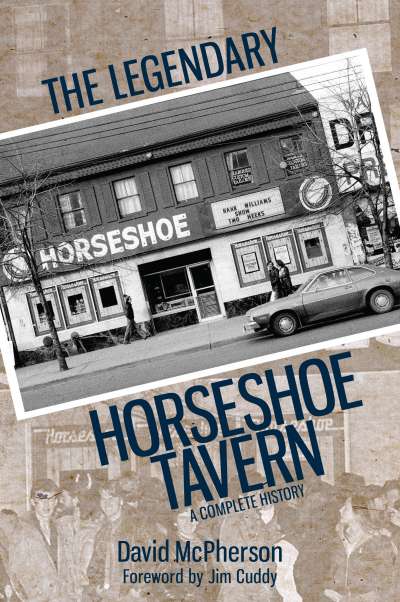David McPherson. The Legendary Horseshoe Tavern: A Complete History. Dundurn Press. $21.99, 208 pp., ISBN: 978-1459734944
A Review of David McPherson's The Legendary Horseshoe Tavern: A Complete History
Review by Jessica Rose
The Legendary Horseshoe Tavern: A Complete History ends with a call to action: “... I encourage you to do your part to support live music wherever you live,” writes David McPherson, a music journalist and the book’s author. “At the end of the day, that’s what will keep clubs like the Horseshoe Tavern open and viable for the next generation.”
A timely book of music nostalgia, The Legendary Horseshoe Tavern explores one of the country’s most famous music venues — an institution with a nondescript facade that has stood at 370 Queen Street West since 1947. While McPherson has written his book in commemoration of the ’Shoe’s 70th anniversary in December, it also comes during a year in which historic venues like Zaphod Beeblebrox in Ottawa and the Silver Dollar Room in Toronto have closed. In Hamilton, our own Baltimore House on King William Street shut its doors in the spring.
McPherson’s passion for music and the Horseshoe Tavern is evident as he takes readers inside the bar that the Tragically Hip immortalized in their song “Bobcaygeon” with the lyrics, “That night in Toronto/ With its checkerboard floors.” The Horseshoe Tavern was one of the first places in Toronto to get a liquor license and the first to have a television set. It was also the place for bands, including Blue Rodeo and countless others, to get their first real break.
Told chronologically, The Legendary Horseshoe Tavern begins when the venue opened at the edge of postwar Toronto’s garment district, appealing to blue-collar factory workers. In its early days, the ’Shoe found great success as Nashville North, a gathering place for Maritimers, who arrived in Toronto looking for work, to enjoy country and western music. Over the years, the Horseshoe Tavern changed ownership and has reinvented itself time after time, hosting some of the biggest acts of the 20th century, including The Rolling Stones, The Police, and Stompin’ Tom Connors, who still holds the record for most consecutive nights at the Horseshoe.
The Legendary Horseshoe Tavern was surely an enormous undertaking by McPherson who does an excellent job of recreating the venue’s history through archival research and first-hand accounts. However, while it is a factually interesting book, The Legendary Horseshoe Tavern lacks critical analysis, rarely going beyond explaining why the venue was important to the musicians who played it.
The Legendary Horseshoe Tavern misses the opportunity to tell a larger, more universal story about why the ’Shoe and venues like it matter to concert goers who pile into cabs and pay money for the collective experience of watching live music. It fails to capture what music fans — like those who will read this book — and neighbourhoods lose when venues fall victim to skyrocketing rent, development, and gentrification.
Of the 61 interviews cited in The Legendary Horseshoe Tavern’s source list, only five are with women. While entire chapters are dedicated to Stompin’ Tom, The Rolling Stones, and even to Sneezy Waters, a Hank Williams impersonator, greats such as Etta James, Loretta Lynn, and Sylvia Tyson, who all played the Horseshoe, are mentioned only in passing. The book presents a narrow view of Canadian music where the usual suspects — male-driven bands Lowest of the Low, Blue Rodeo, The Watchmen, and Spirit of the West, among others — are elevated against all others. This observation is undoubtedly not only a criticism of this book, but of the Canadian music industry, as well.
The Legendary Horseshoe Tavern is an enjoyable read and a worthy tribute to an unpolished gem that has brought live music to generations of Torontonians. While it provides readers with a glimpse behind the scenes of some of Canada’s biggest bands, it is at its best when it tells stories that haven’t already been told. It’s the tales of the Horseshoe’s blue-collar regulars who slug draught beer at the bar, or long-time bartenders, Teddy Fury and Bob Maynard, who have served ’Shoe patrons for decades, that feel most significant.

